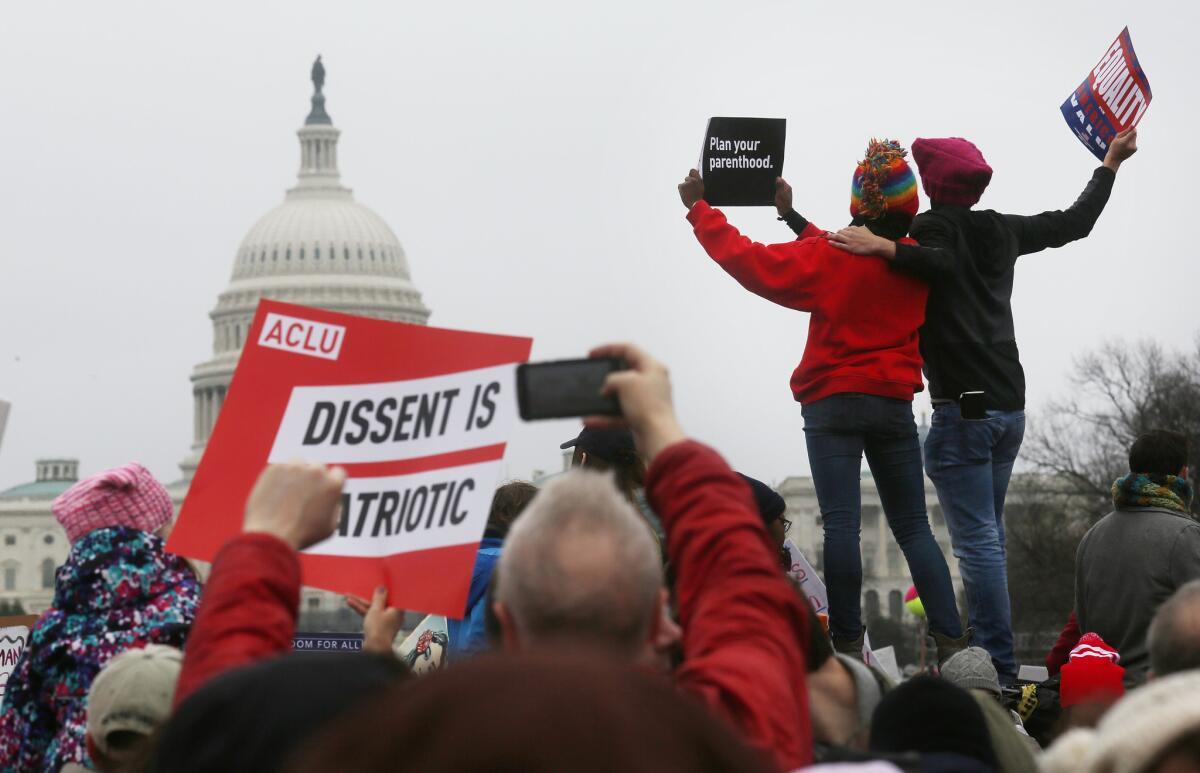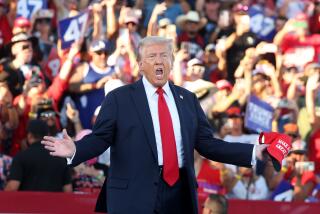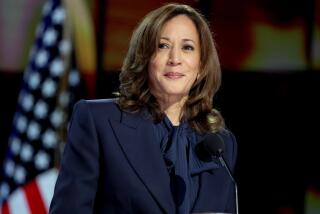Analysis: Huge rallies may signal an emerging anti-Trump movement. But sustaining unity could prove difficult

Reporting from Washington â The new lines of conflict in America were vividly drawn Saturday: A freshly revived protest movement has risen to greet a president acutely attuned to public opinion.
Not for decades, since 1960s protesters took to the streets against the Vietnam War, has a chief executive faced such visible opposition. And never in memory has a new president faced such widespread and intense criticism in the first 24 hours of his term.
Saturday unfolded as a jagged contrast in civic cultures: As Trump took part in the rituals of a new presidency, attending an ecumenical prayer service at the National Cathedral, hundreds of thousands of protesters flocked to attend the Womenâs March on Washington on the nearby National Mall.
A sea of pink hats â the symbol adopted by many attendees â flooded past workers taking down the grandstands for Trumpâs inauguration and parade on Friday. Subway stations across the D.C. area were so clogged that operators recommended walking miles into town. Similar turnouts totaling more than a million nationwide appeared in major cities from Boston to Chicago to Los Angeles.
âThis is the moment of the beginning of the revival of the womenâs movement,â Sen. Kirsten Gillibrand of New York declared to the crowd in Washington.
But is it? Despite the turnout, questions remain: Will protesters unified against Trump in the wake of a divisive campaign stay together or splinter? Will the already unpopular president change in any substantial way as a result of protests or dig in? And will protests accrue to his benefit or detriment among Americans who have not already picked a side in the fight?
Talk of how to sustain momentum against Trump reverberated through the crowds, as marchers spoke of trying to form a lasting opposition.
âI will help sustain it because he stands against everything America is for, in my opinion,â said Sheila Thunboe, 63, who traveled to the Washington march from her home in Denver, en route to business meetings in Miami.
It was her first protest, Thunboe said, since sheâd marched against the Vietnam War while a college student.
The gatherings across the country reflected in some ways the divided presidential vote, with huge crowds in urban centers that went to Hillary Clinton and smaller events in areas dominated by Trump. Collectively, however, they posed an immense public relations problem for the new president, who already was coming into office with record low approval ratings.
His day was spent in part trying to smooth over another dispute, traveling to the CIA mid-afternoon to express his support for the agency. His appearance followed weeks of squabbling with intelligence agencies about their determination that Russia had worked to defeat Clinton with a disinformation and hacking campaign.
Trump had no immediate response to the dayâs protests, a departure from his usual practice, although he did indulge in a lengthy attack on the news media for reporting that the size of the crowd at his inauguration had been smaller than the audience for Barack Obamaâs first swearing-in in 2009.
Trump has in the past proved exceptionally sensitive to the publicâs perception of him. In almost every campaign event, he either boasted about his standing in polls â if he was winning â or, if not, lacerated pollsters.
He has also continuously claimed, wrongly, that the news media never reported his sizable campaign crowds. Recently, he took to Twitter to mock Arnold Schwarzenegger for not getting the high ratings he had received on NBCâs âCelebrity Apprentice.â
The sensitivity has extended to couching his policy positions in more popular ways. In an interview with the Washington Post a few days before his swearing-in, Trump contended that his healthcare plan would include âinsurance for everybody,â a description more encompassing than heâd uttered previously. He said that he had paid attention to critics in crafting his plan. (Aides later said his words went beyond what his plan actually would do.)
Trumpâs insistence on not only being popular, but being recognized for it, led some on Saturday to hope that the mass protests would catch his attention.
âHeâs a narcissist, and he seems to hopefully care what other people think of him,â said Lisa Ellern-Feldman of Chevy Chase, Md., who was pushing a stroller on a long walk to the Washington protest site. âI donât know. Letâs hope.â
But the task ahead of protesters is potentially more difficult â maintaining unity despite the disparate issues and ideologies that brought the crowds together on Saturday.
The protests replicated one of the problems that limited Clintonâs appeal in November: Many people disapproved of Trump, but absent a well-honed reason to vote for Clinton, they lost interest in the election.
Protesters mentioned a range of reasons for their attendance, from Trumpâs Cabinet picks to his campaign rhetoric to his intentions regarding funding of the arts. Republican plans to defund Planned Parenthood and repeal the Affordable Care Act, or Obamacare, were huge draws.
âPeople were brought together mostly by their opposition to him,â said Patrick Egan, an NYU political scientist. âBut it was not like rallies for reproductive rights or gay rights.â
âOften without unifying issues, it is difficult to sustain that unity,â he said.
Recent history has demonstrated the alternatives for protest groups. The conservative tea party movement rose in opposition to President Obama and his healthcare and economic stimulus plans. By filling congressional town halls with their protests, they helped to fuel unified Republican opposition to the president â and pushed their own party in a more conservative direction.
The Occupy Wall Street protesters, on the other hand, failed to turn their organization into that kind of powerhouse and ended up in a niche ignored by both parties.
They also proved a truth about protests: The ones that come to represent extremes rarely manage to benefit their cause and instead empower their opponents. Violent protests against Trump during the campaign often solidified support for him among voters who disagreed with the tactics of the opposition and saw him as a victim.
The party with the most to gain from the protests also faces its own difficulties. Democrats have been casting about for a direction ever since the primary battle between Clinton and Sen. Bernie Sanders of Vermont.
For all the spirit showed by the protesters, the day was filled with reminders of splits that have yet to be repaired.
Clinton, who never inspired the sort of passion that powered Saturdayâs rallies, tweeted her support for the marchers.
âThanks for standing, speaking & marching for our values,â she said, and then invoked her campaign slogan. âI truly believe weâre always Stronger Together.â
Rep. Debbie Wasserman Schultz of Florida, blamed by some in her party for opposing Sanders while she was a supposedly neutral Democratic National Committee chair, spoke from the Washington stage.
So did filmmaker Michael Moore, whose statements effectively sought to impugn both of them.
âThe old guard of the Democratic party has to go,â said Moore, who endorsed Sanders during the primaries. âWe need new leadership.â
The day also highlighted the varied choices ahead as Democrats seek to fill a leadership vacuum after the departure of Obama and the Clintons.
âWe can whimper, we can whine, or we can fight back,â Sen. Elizabeth Warren of Massachusetts, a liberal favorite, said at the Boston gathering. âIâm here to fight backâŚWe are here, we will not be silent, we will not play dead. We will fight for what we believe in.â
In Washington, Sen. Kamala Harris, the California Democrat who has gained notice in the weeks since she took office, offered a passionate assertion of the crowdâs potential.
âWe the people have the power,â she said, as if willing the protesters to surmount their different priorities.
âItâs going to be harder before it gets easier. I know we will rise to the challenge and I know we will keep fighting no matter what,â she said.
âLetâs buckle in because itâs going to be a bumpy ride.â
Twitter: @cathleendecker
ALSO:
Massive march in Los Angeles said to be largest in over a decade
Updates on California politics
Live coverage of the Trump transition
More to Read
Get the L.A. Times Politics newsletter
Deeply reported insights into legislation, politics and policy from Sacramento, Washington and beyond. In your inbox three times per week.
You may occasionally receive promotional content from the Los Angeles Times.











